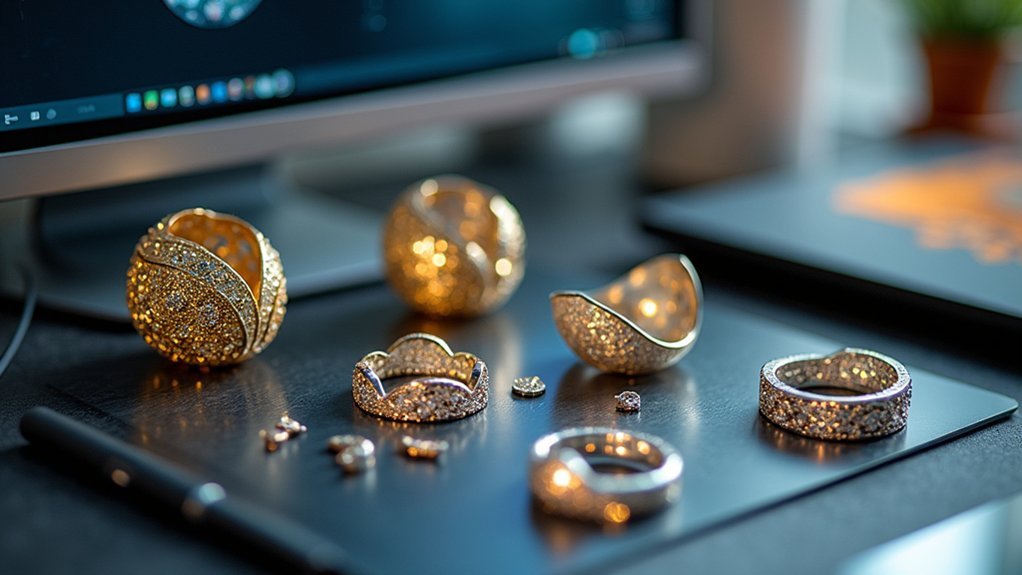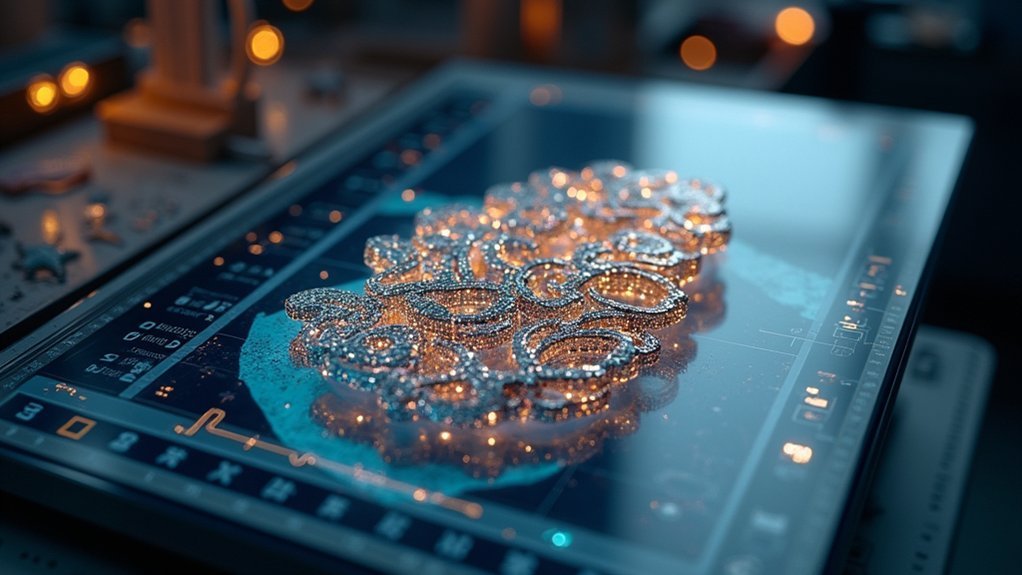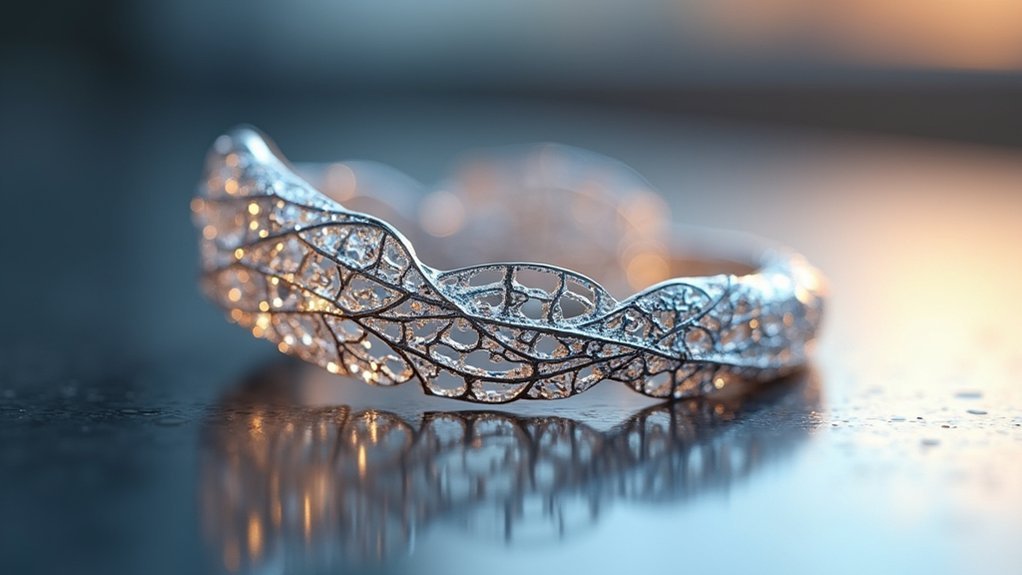You’ll create hollow form jewelry using CAD software like Rhino or SolidWorks by mastering parametric modeling for precise wall thickness control between 0.5mm to 1.5mm. Start with 2D sketches, then use extrusion tools and Boolean operations to build complex geometries. You must include strategic drainage holes to prevent casting vacuum formation and incorporate support structures to avoid wall collapse during production. Advanced techniques involve mirroring for symmetrical designs and simulation tools for predicting metal flow. These fundamentals will enable sophisticated hollow jewelry creation methods.
Understanding CAD Software for Hollow Form Design

How can jewelry designers transform complex hollow form concepts into precise, manufacturable pieces?
You’ll find that CAD software provides the essential tools needed for creating sophisticated hollow jewelry designs with exceptional accuracy. Programs like Rhino and SolidWorks offer specialized features that let you manipulate complex geometries while maintaining proper wall thickness throughout your hollow structures.
CAD software delivers the precision tools essential for transforming complex hollow jewelry concepts into manufacturable designs with exceptional accuracy.
You can visualize every detail of your design in 3D before committing to production, which saves both time and materials. The software enables you to simulate the casting process, helping you anticipate potential issues like wall collapse during metal injection.
You’ll also benefit from CAD’s ability to generate precise technical drawings and specifications, streamlining communication with manufacturers and markedly reducing production errors in your hollow form jewelry pieces.
Essential Tools and Features for Creating Hollow Jewelry
When you’re designing hollow jewelry in CAD, your success depends on mastering specific tools that handle complex three-dimensional forms.
You’ll need parametric modeling software that lets you create hollow forms efficiently while adjusting dimensions without starting over.
Making hollow jewelry requires drainage hole features and support structure tools that guarantee successful casting outcomes.
Whether you’re working with sterling silver designs or Metal Clay projects, rendering capabilities help you visualize textures and materials before production.
Advanced simulation tools can predict metal flow during casting, preventing wall collapse issues that plague hollow jewelry making.
These essential features transform your design process, helping you look forward to creating best sellers that showcase intricate hollow forms with structural integrity and professional quality.
Step-by-Step Process for Modeling Hollow Forms

Although creating hollow jewelry forms might seem challenging at first, you’ll find the process becomes intuitive once you follow a systematic approach.
Start by creating a 2D sketch of your desired shape, carefully considering wall thickness for structural integrity. Next, use the extrusion tool to convert your sketch into a 3D model, adjusting height while hollowing out the interior space.
Apply Boolean operations to subtract shapes from the main body, creating intricate designs and internal features.
Don’t forget to incorporate support structures within your hollow design—these prevent collapse during metal casting, ensuring successful injection molding.
Finally, utilize rendering features to visualize your piece with realistic materials and textures. This allows you to make necessary adjustments before moving to prototyping or production phases.
Advanced Techniques for Complex Hollow Structures
As your jewelry designs grow more sophisticated, you’ll need to master advanced hollow structure techniques that go beyond basic extrusion methods. Utilizing mirrored designs streamlines symmetrical piece creation, enhancing precision while reducing manual adjustments.
Mastering sophisticated hollow structure techniques and mirrored designs elevates jewelry creation beyond basic methods while streamlining precision work.
You can implement slush casting methods in your CAD workflow to design hollow wax forms with intricate internal structures, optimizing weight and material usage effectively.
Integrate electroforming processes into your models to produce lightweight hollow items that maintain structural integrity despite complex shapes and patterns. Simulate hydraulic presses and die-cut halves for consistent manufacturing results.
Remember to incorporate drainage holes and atmospheric openings in your designs—they’re essential for preventing vacuum formation during metal casting. These techniques guarantee your hollow jewelry pieces cast successfully while maintaining their intended structural properties.
Material Considerations and Wall Thickness in CAD

Material selection forms the foundation of successful hollow jewelry CAD design, directly impacting both structural integrity and manufacturing feasibility.
You’ll want to choose sterling silver or base metals that provide adequate strength while maintaining lightweight characteristics essential for comfortable wear.
Your wall thickness should typically range between 0.5mm to 1.5mm. This range guarantees structural integrity without creating excessive weight that compromises the design’s purpose.
CAD software gives you precise control over these measurements, allowing you to visualize and modify thickness throughout your design process.
Don’t forget to incorporate drainage holes in your CAD model. These prevent vacuum formation during casting, which is vital for maintaining your hollow structure and avoiding collapse.
Consider your material’s melting point, as this affects casting requirements and necessary wall thickness to withstand injection pressure.
Converting CAD Models to Physical Jewelry Pieces
Once you’ve perfected your hollow form design in CAD, you’ll need to transform that digital model into a tangible jewelry piece.
You can achieve this through traditional casting methods where your CAD file guides the creation of investment molds, or you can embrace modern 3D printing techniques that build your design layer by layer using specialized resins or metals.
Both approaches offer distinct advantages—casting provides traditional finishing qualities while 3D printing delivers unprecedented geometric complexity and rapid prototyping capabilities.
CAD to Casting
When you’ve perfected your hollow form design in CAD software, the next essential step involves transforming your digital creation into a tangible jewelry piece ready for casting.
You’ll need to convert your CAD model into a physical prototype using 3D printing or CNC machining techniques. These methods guarantee accurate reproduction of your intricate geometries and precise dimensions.
During this conversion process, you should incorporate essential casting features like drainage holes into your design. These holes allow proper molten metal flow and prevent casting defects that could compromise your piece’s integrity.
Your CAD software enables you to experiment with complex lightweight structures while maintaining aesthetic appeal.
Once you’ve created your physical prototype, you can proceed with traditional casting methods, followed by finishing processes including sanding, polishing, and texturing to achieve your desired final appearance.
3D Printing Methods
3D printing methods revolutionize how you transform CAD models into physical jewelry prototypes, offering unprecedented freedom in creating complex hollow forms.
Selective Laser Sintering (SLS) and Fused Deposition Modeling (FDM) enable direct creation from your CAD designs using plastics and metals. You’ll start with a 3D CAD model that’s sliced into layers by software, guiding the printer to build layer by layer for accurate geometric replication.
Hollow designs reduce your piece’s weight while maintaining structural integrity, creating comfortable, cost-effective jewelry.
You can apply post-processing techniques like polishing, casting, or electroforming to enhance surface finish and durability.
As of October 2023, improved precision and expanded material options let you create unique hollow forms previously impossible through traditional methods.
Frequently Asked Questions
How to Make Hollow Jewellery?
You’ll create hollow jewelry by designing 3D CAD models with internal cavities, using slush casting or electroforming techniques, incorporating drainage holes, and thoroughly cleaning hollow interiors before final assembly.
What Is the Full Form of CAD in Jewelry?
CAD stands for Computer-Aided Design in jewelry making. You’ll use this software technology to create precise digital models and drawings of jewelry pieces before manufacturing them physically into final products.
How Much Does a Jewelry CAD Design Cost?
You’ll pay $50-$200 per hour for jewelry CAD design, or $300-$1,500 for flat-fee projects. Simple designs start around $100, while complex custom work exceeds $1,000, plus additional revision costs.
In Summary
You’ve now mastered the essential hollow form jewelry CAD techniques that’ll transform your design capabilities. With proper software knowledge, modeling skills, and material considerations, you can create stunning lightweight pieces that weren’t possible before. Remember to optimize wall thickness, use advanced surface tools, and plan your manufacturing process carefully. These techniques will help you develop innovative hollow jewelry designs that stand out in today’s competitive market while maintaining structural integrity.





Leave a Reply